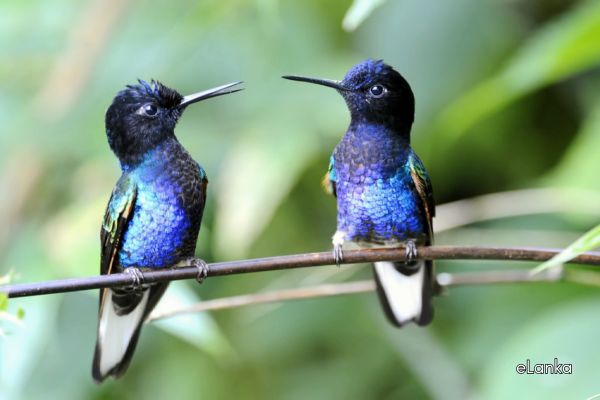The Smallest Wonders: Tiny Birds that Amaze the World – By Nadeeka – eLanka

Birds are among nature’s most diverse and fascinating creatures, ranging vastly in size, shape, color, and behavior. Amidst this diversity, the smallest birds in the world hold a unique charm, showcasing an impressive range of adaptations and surprising abilities despite their tiny stature. These tiny marvels capture our attention with their diminutive size, vibrant colors, and incredible agility.
In this article, we’ll explore some of the world’s smallest birds, their remarkable behaviors and habitats, and the conservation efforts needed to ensure their survival.
Hummingbirds: Nature’s Smallest Aviators
Without a doubt, hummingbirds are some of the tiniest and most enchanting birds on Earth. Renowned for their ability to hover and their rapid wingbeats—reaching up to 80 beats per second—they navigate the air like miniature helicopters. These birds mainly feed on nectar from flowers, occasionally consuming tiny insects for protein.
Bee Hummingbird (Mellisuga helenae) – World’s Smallest Bird
The Bee Hummingbird (Mellisuga helenae) is officially recognized as the smallest bird in the world. Native to Cuba, it measures roughly 5 centimeters in length and weighs just about 2 grams—comparable to a penny. Their nests are equally miniature, about the size of a walnut shell. Despite their size, these tiny birds are vibrant in color, shimmering with iridescent blues and greens. Their tiny stature does not diminish their resilience, as they migrate impressively long distances each year.
The Weebill: Australia’s Diminutive Delight
Weighing approximately 6 grams and averaging 8 centimeters in length, the Weebill (Smicrornis brevirostris) is Australia’s smallest bird. These tiny songbirds inhabit woodlands and savannas, thriving primarily on insects and spiders, and their compact size helps them maneuver easily through dense foliage. Despite their small size, Weebills, as they’re affectionately known, exhibit incredible vocalizations, filling their habitats with cheerful and complex songs.
Goldcrest: Europe’s Miniature Songster
In Europe, the Goldcrest (Regulus regulus) holds the distinction of being the continent’s smallest bird. Weighing around 5 grams, the Goldcrest is just slightly larger than the Bee Hummingbird. They inhabit coniferous forests, continuously moving through branches in search of insects. With their vivid golden-yellow head stripe and energetic movements, these birds enchant birdwatchers and naturalists alike. Goldcrests must consume food constantly to sustain their high-energy lifestyle, especially during cold European winters.
Bushtit: North America’s Charming Socialite
In North America, one of the smallest birds is the Bushtit (Psaltriparus minimus). Weighing just around 5 grams and measuring approximately 7 centimeters, these birds roam in cheerful, social flocks, energetically exploring trees and bushes for small insects. They are well known for their cooperative behavior, often moving through habitats in groups of up to several dozen individuals. Their nests, carefully crafted from spider silk, moss, and feathers, are remarkable architectural achievements.
Pardalote: Australia’s Colorful Gem
Australia boasts small avian wonders as well, notably the Pardalote. Species like the Spotted Pardalote (Pardalotus punctatus) are tiny, vibrant birds that thrive in eucalyptus forests. Their striking plumage—black wings dotted with white and bright splashes of yellow and orange—belies their tiny size. Pardalotes are not only beautiful but vital to ecosystems, as they help control insect populations that damage trees. These small birds construct elaborate nesting tunnels in sandy banks or tree hollows, protecting their chicks from predators and harsh weather.
Sunbirds: Africa and Asia’s Dazzling Pollinators
Sunbirds, found predominantly in Africa and Asia, represent some of the most vividly colored small birds globally. Despite resembling hummingbirds in behavior and diet, sunbirds do not hover; instead, they perch while feeding. Species such as the Variable Sunbird (Cinnyris venustus) are famous for their dazzling iridescent plumage, featuring brilliant shades of blues, purples, greens, and yellows. Like hummingbirds, sunbirds play crucial roles as pollinators, fostering the growth and proliferation of local flora.
Why Size Matters: Ecological Importance of Small Birds
Small birds, despite their modest size, are essential for ecosystem health. They pollinate flowers, disperse seeds, control insect populations, and provide food sources for larger predators. Their role as bioindicators—species whose health reflects the broader environmental condition—makes them invaluable. When small birds thrive, it often signals a healthy ecosystem; their decline can warn of ecological distress requiring immediate attention.
Conservation Concerns for Tiny Birds
Unfortunately, these delicate birds often face significant threats due to habitat loss, climate change, pesticide use, and introduced predators. Their small size, limited habitat ranges, and high energy requirements make them especially vulnerable to environmental changes and habitat destruction. Conservation efforts worldwide must prioritize protecting their habitats, minimizing pollution, and supporting sustainable ecological practices.
What Can You Do to Help?
Everyone can play a role in safeguarding these delightful birds:
- Support conservation programs: Donate to organizations dedicated to bird conservation.
- Plant native gardens: Encourage biodiversity by planting native flowering plants in your garden, which serve as food sources and habitats.
- Reduce pesticide usage: Encourage natural pest management strategies to protect insect populations, essential food sources for small birds.
- Educate others: Raise awareness about small birds’ importance and vulnerability.
- Participate in citizen science projects: Help track bird populations through local surveys or global initiatives like eBird.
Final Thoughts: Celebrating Nature’s Smallest Wonders
The smallest birds of the world offer humanity an extraordinary lesson in adaptability, resilience, and ecological interconnectedness. From the delicate beauty of hummingbirds in the Americas to the vibrant sunbirds of Africa and Asia, these small wonders continually captivate and inspire awe among nature lovers and scientists alike.
By appreciating and protecting these birds, we foster a healthier planet and gain deeper insights into the interconnected nature of ecosystems. Celebrating these tiny marvels reminds us of nature’s boundless creativity and the crucial role each species plays, no matter how small, in our shared environment.























